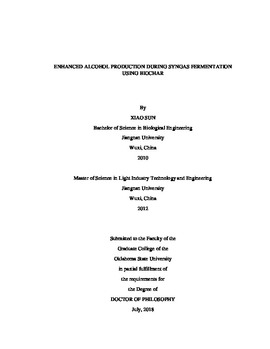| dc.description.abstract | Microbial fermentation of syngas (mainly CO, H2 and CO2) into biofuels (ethanol, butanol, etc.) and chemicals (carboxylic acids, 2,3-butanediol, etc.) is a flexible and promising route for producing liquid biofuels and chemicals. Biochar obtained from gasification or pyrolysis of the carbon-rich feedstocks contains rich mineral and metal compounds, high pH buffering capacity, and cation exchange capacity (CEC). The use of biochar in syngas fermentation could lead to enhanced production of biofuels and chemicals. In the present study, biochar from switchgrass (SGBC), forage sorghum (FSBC), red cedar (RCBC) and poultry litter (PLBC) were incorporated into fermentation media of C. ragsdalei and C. carboxidivorans. Fermentations were performed in 250 mL bottle reactors with 50 mL working volume fed with bottled syngas (40% CO, 30% H2, 30% CO2, by volume) at 37°C for 15 days. Fermentations with C. ragsdalei showed that PLBC and RCBC improved ethanol production by 59% and 16%, respectively, compared to standard YE medium. Fermentations with C. carboxidivorans showed that media with PLBC and SGBC enhanced ethanol production by 90% and 73%, respectively, and butanol production by four fold compared to standard YE medium. PLBC loading of 10 and 20 g L-1 was shown to enhance ethanol and acetic acid productions with C. ragsdalei and enhance ethanol, butanol, acetic acid, butyric acid, and hexanoic acid productions with C. carboxidivorans. A 10 g L-1 of PLBC was used in fed-batch fermentation with C. ragsdalei in 3-L CSTR. The highest amounts of acetic acid produced in YE medium without MES, PLBC media without and with MES were 0.6, 1.2, and 2.0 g L-1, respectively. The acetic acid produced in all media was completely converted to ethanol using a patented pH controller and syngas feeding method. Fermentations using PLBC media without and with MES resulted in production of 34% and 63%, respectively, more ethanol than in YE medium. Ca, Mg, Fe and Mn were mostly released from biochar during syngas fermentation with C. ragsdalei and C. carboxidivorans. The release of these elements was caused by neutralization with H+ from undissociated acetic acid during acetogenic phase in fermentation. The reduced H+ led to deceleration in pH drop, which extended acetogenic phase with accumulation of more acetic acid and reduced "acid stress" on the microorganisms used. Compared with other types of biochar materials, PLBC had the highest pH buffering capacity, total bound cations and acid neutralizing capacity, which contributed to the enhancement of alcohol and acid production with potential use in commercial syngas fermentation processes. | |
